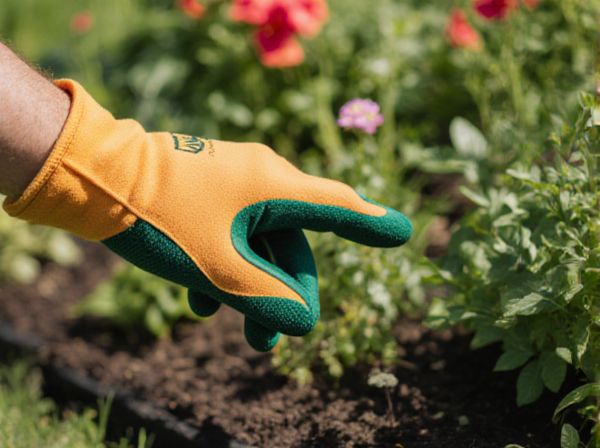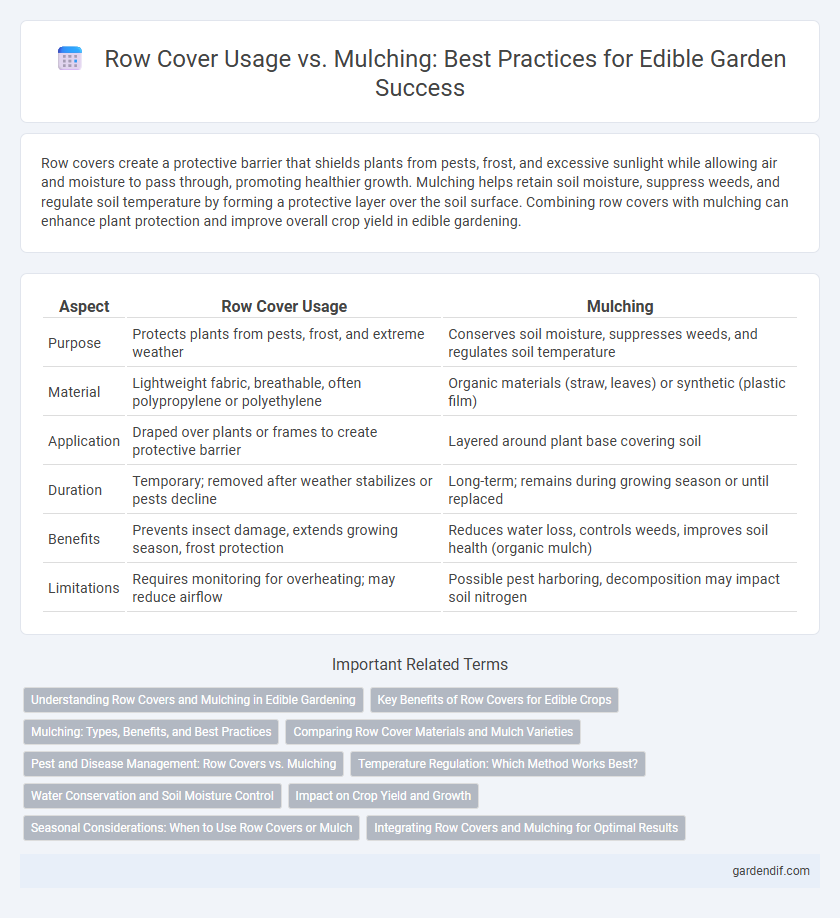
Row Cover Usage vs Mulching Illustration
Row covers create a protective barrier that shields plants from pests, frost, and excessive sunlight while allowing air and moisture to pass through, promoting healthier growth. Mulching helps retain soil moisture, suppress weeds, and regulate soil temperature by forming a protective layer over the soil surface. Combining row covers with mulching can enhance plant protection and improve overall crop yield in edible gardening.
Table of Comparison
| Aspect | Row Cover Usage | Mulching |
|---|---|---|
| Purpose | Protects plants from pests, frost, and extreme weather | Conserves soil moisture, suppresses weeds, and regulates soil temperature |
| Material | Lightweight fabric, breathable, often polypropylene or polyethylene | Organic materials (straw, leaves) or synthetic (plastic film) |
| Application | Draped over plants or frames to create protective barrier | Layered around plant base covering soil |
| Duration | Temporary; removed after weather stabilizes or pests decline | Long-term; remains during growing season or until replaced |
| Benefits | Prevents insect damage, extends growing season, frost protection | Reduces water loss, controls weeds, improves soil health (organic mulch) |
| Limitations | Requires monitoring for overheating; may reduce airflow | Possible pest harboring, decomposition may impact soil nitrogen |
Understanding Row Covers and Mulching in Edible Gardening
Row covers provide edible gardens with frost protection, pest exclusion, and improved microclimate conditions, enhancing crop growth and yield. Mulching conserves soil moisture, suppresses weeds, and regulates soil temperature, creating optimal root environment for vegetables and herbs. Combining row covers with organic mulches can synergistically boost plant health and productivity in edible gardening.
Key Benefits of Row Covers for Edible Crops
Row covers significantly enhance the growth of edible crops by providing protection against pests and frost, extending the growing season and improving crop yield. They create a microclimate that conserves moisture and regulates temperature, reducing water stress and promoting healthier plants. Unlike mulching, row covers allow for better air circulation while still shielding crops from harmful environmental factors.
Mulching: Types, Benefits, and Best Practices
Mulching involves applying organic or inorganic materials such as straw, wood chips, or plastic film around edible plants to conserve soil moisture, regulate temperature, and suppress weeds. Common types include organic mulches like compost and bark, which enrich soil nutrients, and inorganic mulches like black plastic, which excel in weed control and soil warming. Best practices recommend applying mulch in a 2-4 inch layer, avoiding direct contact with plant stems, and replenishing mulch seasonally to maintain effectiveness in vegetable and fruit crop production.
Comparing Row Cover Materials and Mulch Varieties
Row covers typically come in lightweight spunbonded polyester or polypropylene fabrics, providing frost protection and pest control while allowing air and moisture exchange. Mulch varieties include organic options like straw, wood chips, and compost, which enrich soil fertility, and synthetic types such as black plastic or landscape fabric, which primarily control weeds and retain soil moisture. Selecting between row cover materials and mulch depends on specific garden goals, with row covers enhancing plant microclimates and mulches improving soil health and moisture retention.
Pest and Disease Management: Row Covers vs. Mulching
Row covers create a physical barrier that prevents insect pests from reaching edible crops, significantly reducing infestations without chemical intervention. Mulching helps manage disease by maintaining soil moisture and temperature, which can suppress certain soil-borne pathogens and reduce weed competition that harbors pests. Combining row covers with mulching optimizes pest and disease management by protecting plants above ground while fostering a healthy root environment.
Temperature Regulation: Which Method Works Best?
Row covers provide superior temperature regulation by trapping heat and creating a microclimate that promotes faster plant growth in cooler conditions. Mulching stabilizes soil temperature by insulating against daytime heat and nighttime cold but does not significantly raise ambient temperature around plants. For optimal temperature control, combining row covers with mulch offers enhanced protection and consistent warmth for edible crops.
Water Conservation and Soil Moisture Control
Row covers enhance water conservation by reducing soil evaporation and protecting plants from wind stress, which maintains higher soil moisture levels. Mulching acts as a barrier that limits water runoff and retains soil moisture by insulating the soil surface, leading to more consistent hydration for edible crops. Combining row covers with organic mulches can optimize water retention and improve overall soil moisture control in vegetable gardens.
Impact on Crop Yield and Growth
Row covers significantly enhance crop yield by protecting plants from pests and frost, maintaining optimal microclimates that promote faster growth and higher productivity. Mulching improves soil moisture retention and temperature regulation, supporting root development and reducing weed competition, which also boosts crop growth and yield. Combining row covers with mulching can synergistically improve crop performance by maximizing environmental protection and soil health benefits.
Seasonal Considerations: When to Use Row Covers or Mulch
Row covers are ideal for early spring and late fall protection, shielding plants from frost and extending the growing season by maintaining warmer soil temperatures. Mulching excels in summer by conserving soil moisture, regulating temperature, and suppressing weeds to support plant health during hot, dry periods. Seasonal use of row covers prevents cold damage, while mulch optimizes soil conditions in warmer months, making both essential for crop success.
Integrating Row Covers and Mulching for Optimal Results
Integrating row covers and mulching maximizes crop protection by combining temperature regulation and moisture retention. Row covers create a microclimate that shields plants from pests and frost, while mulching conserves soil moisture and reduces weed growth. Together, these methods enhance plant health, extend growing seasons, and improve overall yield in vegetable gardens.
Row Cover Usage vs Mulching Infographic

 gardendif.com
gardendif.com